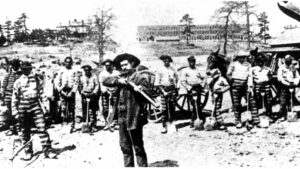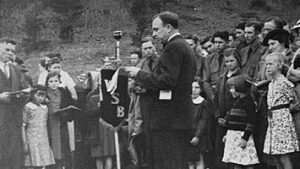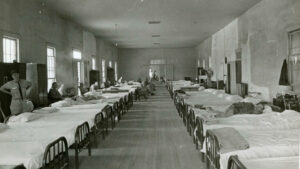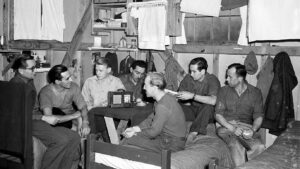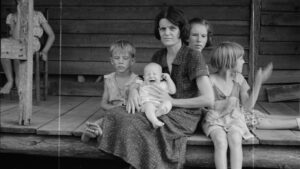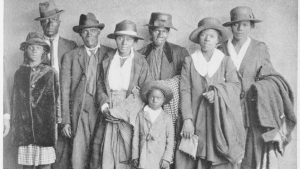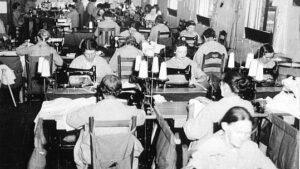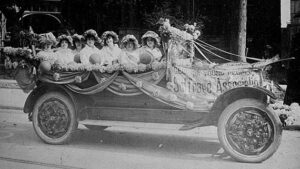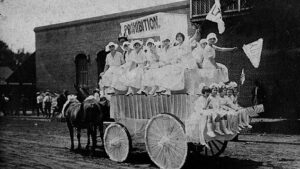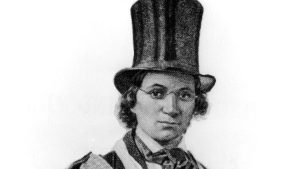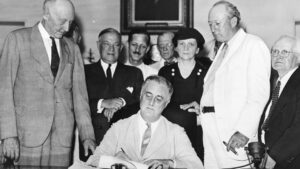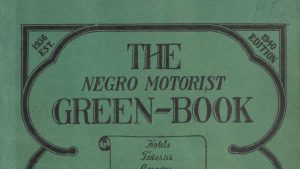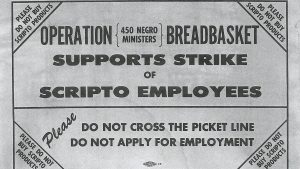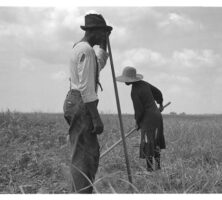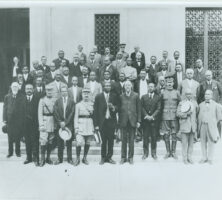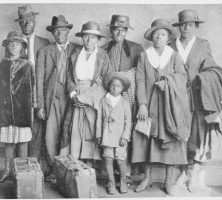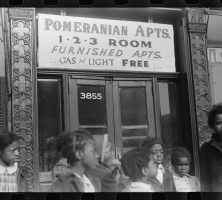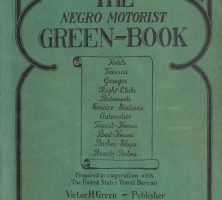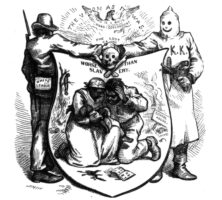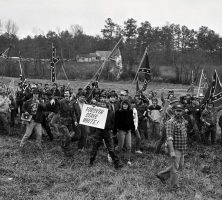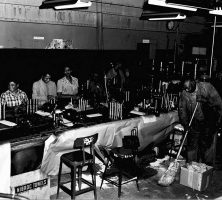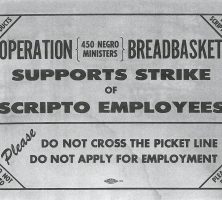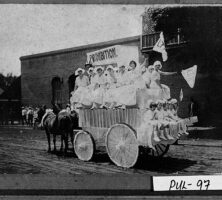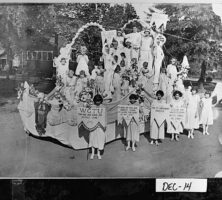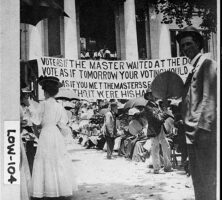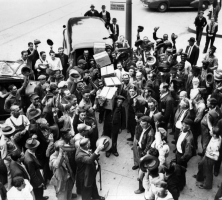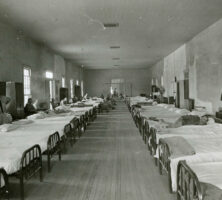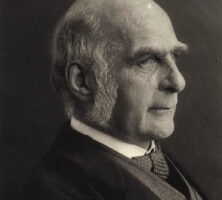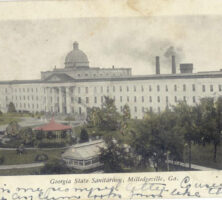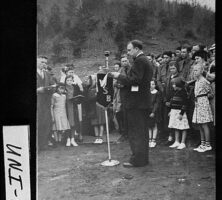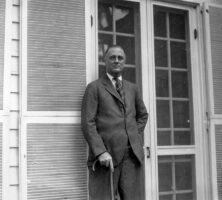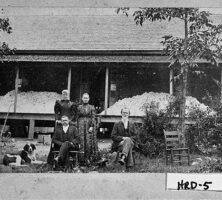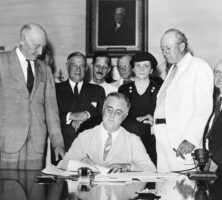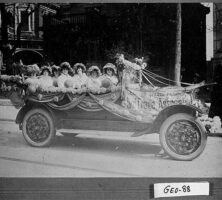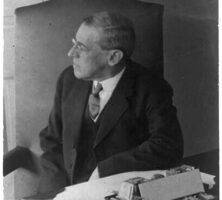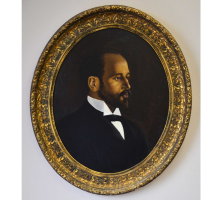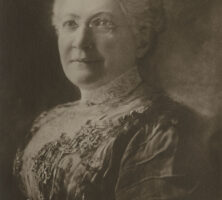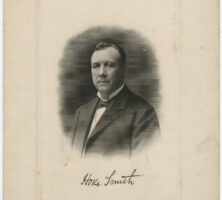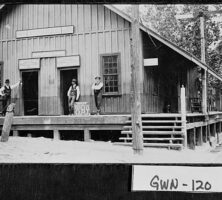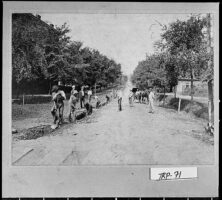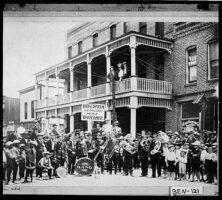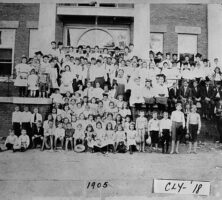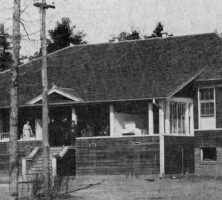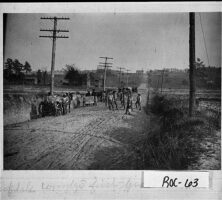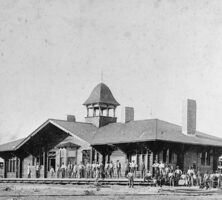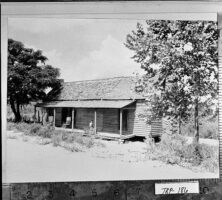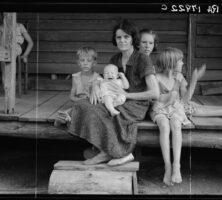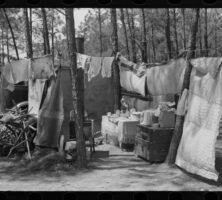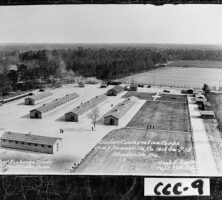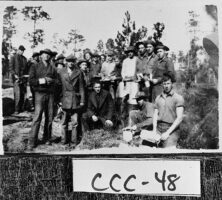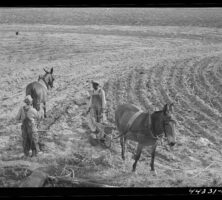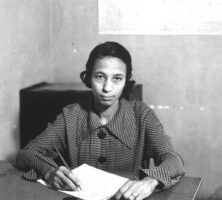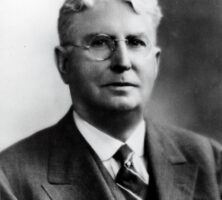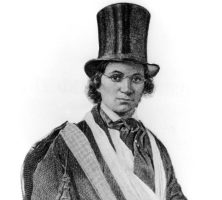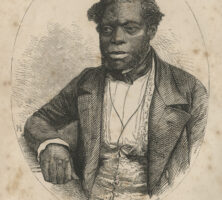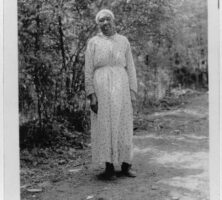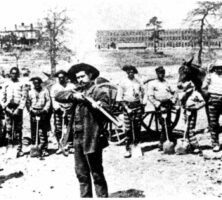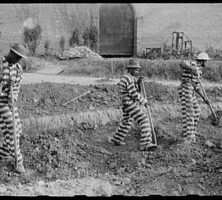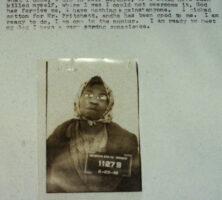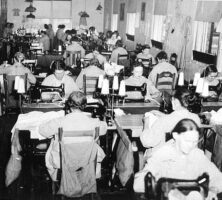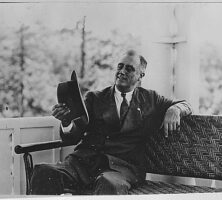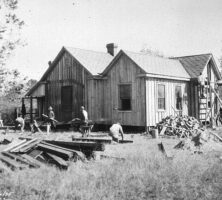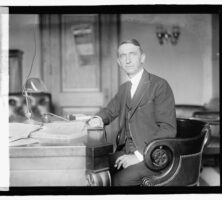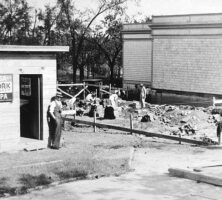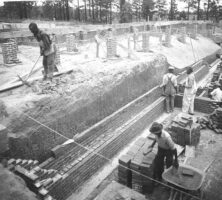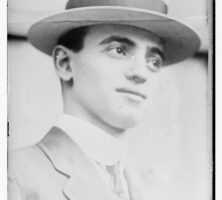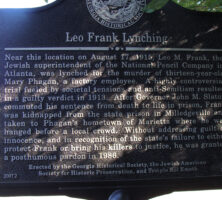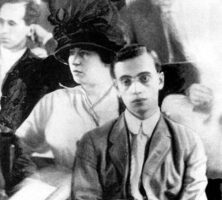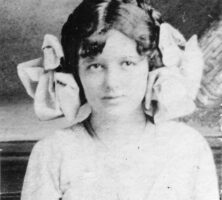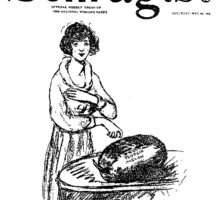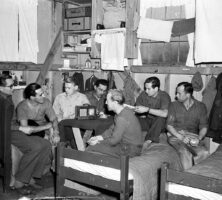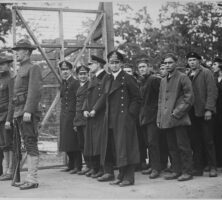The New Georgia Encyclopedia is supported by funding from A More Perfect Union, a special initiative of the National Endowment for the Humanities.
Cotton sharecroppers in Greene County, 1937. The sociologist Arthur F. Raper studied the county in the 1930s and found that soil depletion, low cotton prices, and boll weevil attacks were causing a massive outmigration of farmers.
Courtesy of Library of Congress, Prints and Photographs Division, Photograph by Dorothea Lange, Farm Security Administration - Office of War Information Photograph Collection, #LC-USF34-T01-017335-C.
The New Georgia Encyclopedia does not hold the copyright for this media resource and can neither grant nor deny permission to republish or reproduce the image online or in print. All requests for permission to publish or reproduce the resource must be submitted to the rights holder.
Robert S. Abbott, a Georgia native, was a prominent journalist who founded the Chicago Defender in 1905. He is pictured (second row, fifth from right) in June 1918 at a meeting of Black leaders in Washington, D.C. Prominent historian and educator W. E. B. Du Bois stands in the first row, fourth from the right.
Courtesy of Special Collections and University Archives, University of Massachusetts Amherst Libraries
The New Georgia Encyclopedia does not hold the copyright for this media resource and can neither grant nor deny permission to republish or reproduce the image online or in print. All requests for permission to publish or reproduce the resource must be submitted to the rights holder.
Over the course six decades, roughly 6 million Black southerners moved from the South to the North, Midwest, and West. Driven by the availability of jobs outside the South, as well as the desire to escape racial violence within it, migrants moved primarily from rural, agricultural areas like Georgia’s Black Belt to cities such as Detroit, New York, Los Angeles, and Chicago.
From The New York Public Library, The Negro in Chicago: A Study of Race Relations and a Race Riot, by the Chicago Commission on Race Relations.
The New Georgia Encyclopedia does not hold the copyright for this media resource and can neither grant nor deny permission to republish or reproduce the image online or in print. All requests for permission to publish or reproduce the resource must be submitted to the rights holder.
Black southerners left rural, agricultural areas like Georgia’s Black Belt for cities such as Detroit, New York, Chicago, and Los Angeles. Migrants found their new settings to be an improvement but also full of obstacles. White flight and discriminatory housing policies funneled African Americans into poorer neighborhoods and public housing complexes.
Courtesy of Library of Congress, Prints and Photographs Division, Farm Security Administration/Office of War Information Black-and-White Negatives.
The New Georgia Encyclopedia does not hold the copyright for this media resource and can neither grant nor deny permission to republish or reproduce the image online or in print. All requests for permission to publish or reproduce the resource must be submitted to the rights holder.
The Negro Motorist Green-Book, also known as the Negro Traveller's Green-Book, was an essential guide for Black travelers between 1936 and 1966. This yearly publication, created by postal employee Victor Hugo Green, helped readers avoid sundown towns and locate safe lodging, gas stops, and eateries.
From Wikimedia
The New Georgia Encyclopedia does not hold the copyright for this media resource and can neither grant nor deny permission to republish or reproduce the image online or in print. All requests for permission to publish or reproduce the resource must be submitted to the rights holder.
Most Ku Klux Klan action was designed to intimidate Black voters and white supporters of the Republican Party. Founded in Tennessee in 1866, the Klan was particularly active in Georgia from 1868 to the early 1870s.
From Harper's Weekly
The New Georgia Encyclopedia does not hold the copyright for this media resource and can neither grant nor deny permission to republish or reproduce the image online or in print. All requests for permission to publish or reproduce the resource must be submitted to the rights holder.
White supremacists picketing at the first Brotherhood March on January 17, 1987, in Forsyth County.
Courtesy of Atlanta Journal-Constitution, Atlanta Journal-Constitution Photographic Archive, #AJCNS1987-01-17l.
The New Georgia Encyclopedia does not hold the copyright for this media resource and can neither grant nor deny permission to republish or reproduce the image online or in print. All requests for permission to publish or reproduce the resource must be submitted to the Atlanta Journal-Constitution.
Between 1931 and 1977, Black female employees at the Scripto factory in Atlanta organized against unfair wages and a discriminatory work environment. Their activism was a precursor to the civil rights movement.
Courtesy of Special Collections & Archives, Georgia State University Library, Lane Brothers Commercial Photographers Photographic Collection, #LBCB095-022a.
The New Georgia Encyclopedia does not hold the copyright for this media resource and can neither grant nor deny permission to republish or reproduce the image online or in print. Requests for permission to publish or reproduce the resource should be submitted to Special Collections and Archives at Georgia State University.
Black women made up more than 80 percent of the workforce at Scripto's factory in Atlanta. This 1958 advertisement depicts ballpoint pens, one of the company's most popular products.
Image from James Vaughan
The New Georgia Encyclopedia does not hold the copyright for this media resource and can neither grant nor deny permission to republish or reproduce the image online or in print. All requests for permission to publish or reproduce the resource must be submitted to the rights holder.
Cigarette lighters, such as the popular Compact Vu-Lighter shown here, were one of Scripto Inc.'s defining products, along with pens and mechanical pencils.
Image from Joe Haupt
The New Georgia Encyclopedia does not hold the copyright for this media resource and can neither grant nor deny permission to republish or reproduce the image online or in print. All requests for permission to publish or reproduce the resource must be submitted to the rights holder.
Operation Breadbasket was created in 1962 as a branch of the Southern Christian Leadership Conference (SCLC). A minister-led program, Operation Breadbasket worked to improve economic conditions in the Black community through boycotts and organized support.
Courtesy of Stuart A. Rose Manuscript, Archives, and Rare Book Library, Emory University, Southern Christian Leadership Records.
The New Georgia Encyclopedia does not hold the copyright for this media resource and can neither grant nor deny permission to republish or reproduce the image online or in print. For more information about this resource, contact the Stuart A. Rose Manuscript, Archives, and Rare Book Library at Emory University.
Young women and children ride on a parade float promoting prohibition in Hawkinsville (Pulaski County), circa 1919.
Courtesy of Georgia Archives, Vanishing Georgia, #
pul097a.
The New Georgia Encyclopedia does not hold the copyright for this media resource and can neither grant nor deny permission to republish or reproduce the image online or in print. Requests for permission to publish or reproduce the resource should be submitted to the Georgia Archives.
Women's Christian Temperance Movement (WTCU) members participate in the Decatur County centennial parade in Bainbridge, 1923. The WCTU formed its first Georgia chapter in 1880. Largely due to their efforts, Georgia passed a local option law in 1885.
Courtesy of Georgia Archives, Vanishing Georgia, #
dec014.
The New Georgia Encyclopedia does not hold the copyright for this media resource and can neither grant nor deny permission to republish or reproduce the image online or in print. Requests for permission to publish or reproduce the resource should be submitted to the Georgia Archives.
A crowd gathered in front of the Lowndes County courthouse in Valdosta for a prohibition vote in 1907. That year, Georgia became the first state in the South to pass a statewide ban on the production, transportation, and sale of alcohol.
Courtesy of Georgia Archives, Vanishing Georgia, #
low104.
The New Georgia Encyclopedia does not hold the copyright for this media resource and can neither grant nor deny permission to republish or reproduce the image online or in print. Requests for permission to publish or reproduce the resource should be submitted to the Georgia Archives.
A crowd in Marietta celebrates the end of prohibition. In 1935 the Georgia legislature approved the Alcoholic Beverage Control Act, which called for a statewide referendum on the issue of repeal and tasked the State Revenue Commission with drafting new regulations to govern the sale and distribution of alcohol.
Courtesy of Special Collections & Archives, Georgia State University Library, Atlanta Journal-Constitution Photographic Archive.
The New Georgia Encyclopedia does not hold the copyright for this media resource and can neither grant nor deny permission to republish or reproduce the image online or in print. Requests for permission to publish or reproduce the resource should be submitted to Special Collections and Archives at Georgia State University.
A sleeping ward at Milledgeville State Hospital for the Insane, circa 1940. Authorities at the hospital practiced compulsory sterilization of patients throughout the 1940s and 1950s. Following an award-winning 1959 report by Atlanta Constitution Jack Nelson, the number of operations dropped dramatically before finally ceasing in 1963.
Courtesy of Special Collections & Archives, Georgia State University Library, Atlanta Journal-Constitution Photographic Archive .
The New Georgia Encyclopedia does not hold the copyright for this media resource and can neither grant nor deny permission to republish or reproduce the image online or in print. Requests for permission to publish or reproduce the resource should be submitted to Special Collections and Archives at Georgia State University.
Francis Galton was an English statistician whose theories on heredity lead him to develop the field of eugenics. During the early twentieth century, Galton's ideas gained support among scientific and medical professionals, politicians, and Progressive-era reform groups.
Image from Eveleen Myers
The New Georgia Encyclopedia does not hold the copyright for this media resource and can neither grant nor deny permission to republish or reproduce the image online or in print. All requests for permission to publish or reproduce the resource must be submitted to the rights holder.
This tinted postcard of the Georgia State Sanitarium (later Central State Hospital) depicts the grounds of the institution circa 1905. During this time the hospital was under the leadership of Theophilus O. Powell, who implemented more precise methods of diagnosis.
Courtesy of Melinda Smith Mullikin, New Georgia Encyclopedia
The New Georgia Encyclopedia does not hold the copyright for this media resource and can neither grant nor deny permission to republish or reproduce the image online or in print. All requests for permission to publish or reproduce the resource must be submitted to the rights holder.
E. D. Rivers speaks in 1939, during his second gubernatorial term, at a gathering in Union County, located in the north Georgia mountains. During his first term, Rivers secured federal funding to support public housing and rural electrification in the state.
Courtesy of Georgia Archives, Vanishing Georgia, #uni005.
The New Georgia Encyclopedia does not hold the copyright for this media resource and can neither grant nor deny permission to republish or reproduce the image online or in print. Requests for permission to publish or reproduce the resource should be submitted to the Georgia Archives.
The soybean plant, first introduced to Georgia in 1765, originated in China. The plant was brought to the Georgia colony by Samuel Bowen, who planted it after settling in Savannah. In the latter part of the nineteenth century, the U.S. Department of Agriculture encouraged the cultivation of soybeans in the state.
Photograph by Carl Dennis, Auburn University. Courtesy of IPM Images
The New Georgia Encyclopedia does not hold the copyright for this media resource and can neither grant nor deny permission to republish or reproduce the image online or in print. All requests for permission to publish or reproduce the resource must be submitted to the rights holder.
In 1924, three years after Roosevelt contracted polio, he began visiting Warm Springs in Georgia. The springs were thought to be beneficial for polio victims. Roosevelt, who became the U.S. president in 1932, is pictured in front of the Little White House in Warm Springs.
Courtesy of Georgia Info, Digital Library of Georgia.
The New Georgia Encyclopedia does not hold the copyright for this media resource and can neither grant nor deny permission to republish or reproduce the image online or in print. Requests for permission to publish or reproduce the resource may need to be submitted to the Digital Library of Georgia.
Members of a Heard County family pose in front of their cotton crop, circa 1900. Residents of the county began raising cotton in the nineteenth century, but many were forced to abandon the crop during the first decades of the twentieth century, in the wake of the boll weevil devastations and the Great Depression.
Courtesy of Georgia Archives, Vanishing Georgia, #
hrd005.
The New Georgia Encyclopedia does not hold the copyright for this media resource and can neither grant nor deny permission to republish or reproduce the image online or in print. Requests for permission to publish or reproduce the resource should be submitted to the Georgia Archives.
Soybeans were introduced to the United States by Samuel Bowen, a seaman who brought the seeds from China. At Bowen's request, Henry Yonge planted the first soybean crop on his farm in Thunderbolt, a few miles east of Savannah, in 1765.
Photograph by the United Soybean Board
The New Georgia Encyclopedia does not hold the copyright for this media resource and can neither grant nor deny permission to republish or reproduce the image online or in print. All requests for permission to publish or reproduce the resource must be submitted to the rights holder.
U.S. president Franklin D. Roosevelt signed the Social Security Act on August 14, 1935. He read this statement upon signing the act: "We can never insure one hundred percent of the population against one hundred percent of the hazards and vicissitudes of life, but we have tried to frame a law which will give some measure of protection to the average citizen and to his family against the loss of a job and against poverty-ridden old age."
Courtesy of Library of Congress, Prints and Photographs Division
The New Georgia Encyclopedia does not hold the copyright for this media resource and can neither grant nor deny permission to republish or reproduce the image online or in print. All requests for permission to publish or reproduce the resource must be submitted to the rights holder.
Riding in a car decorated as a float, representatives of the Georgia Young People Suffrage Association participate in a 1920 parade.
Courtesy of Georgia Archives, Vanishing Georgia, #
geo088.
The New Georgia Encyclopedia does not hold the copyright for this media resource and can neither grant nor deny permission to republish or reproduce the image online or in print. Requests for permission to publish or reproduce the resource should be submitted to the Georgia Archives.
Many of the major Progressive era reforms were enacted at the federal level by Congress, under the leadership of U.S. presidents Theodore Roosevelt, William Howard Taft, and Woodrow Wilson (pictured circa 1920).
Courtesy of Library of Congress, Prints and Photographs Division
The New Georgia Encyclopedia does not hold the copyright for this media resource and can neither grant nor deny permission to republish or reproduce the image online or in print. All requests for permission to publish or reproduce the resource must be submitted to the rights holder.
W. E. B. Du Bois is Georgia's most distinguished example of a progressive intellectual who wed social science to the analysis of public issues. In 1910 he founded the NAACP, one of the most significant products of the Progressive era.
Image from Univeristy of Massachusetts Amherst, Special Collections and University Archives, W. E. B. Du Bois Papers.
The New Georgia Encyclopedia does not hold the copyright for this media resource and can neither grant nor deny permission to republish or reproduce the image online or in print. All requests for permission to publish or reproduce the resource must be submitted to the rights holder.
Nellie Peters Black served three terms as president of the Georgia Federation of Women's Clubs. She led Georgia women in supporting U.S. president Woodrow Wilson's thrift and conservation campaigns during the Progressive era.
Courtesy of Hargrett Rare Book and Manuscript Library, University of Georgia Libraries, Nellie Peters Black Papers.
The New Georgia Encyclopedia does not hold the copyright for this media resource and can neither grant nor deny permission to republish or reproduce the image online or in print. Requests for permission to publish or reproduce the resource should be submitted to the Hargrett Manuscript and Rare Book Library at the University of Georgia.
Governor Hoke Smith is perhaps the figure most associated with Progressive era reform in the state. During his governorship reforms were seen in education and railroad regulation; the convict lease system was abolished; and a major public health project, a state sanatorium for tuberculosis patients, was undertaken.
The New Georgia Encyclopedia does not hold the copyright for this media resource and can neither grant nor deny permission to republish or reproduce the image online or in print. Requests for permission to publish or reproduce the resource should be submitted to the Hargrett Manuscript and Rare Book Library at the University of Georgia.
A postcard depicts passengers waiting outside a segregated train depot in Suwanee (Gwinnett County), circa 1915.
Courtesy of Georgia Archives, Vanishing Georgia, #
gwn120.
The New Georgia Encyclopedia does not hold the copyright for this media resource and can neither grant nor deny permission to republish or reproduce the image online or in print. Requests for permission to publish or reproduce the resource should be submitted to the Georgia Archives.
During his tenure as governor, from 1890 to 1894, William J. Northen limited the workday for railroad employees to thirteen hours and granted the Georgia Railroad Commission power to regulate telegraph companies. He also advanced agricultural inspection and education.
Image from Wikimedia Commons
The New Georgia Encyclopedia does not hold the copyright for this media resource and can neither grant nor deny permission to republish or reproduce the image online or in print. All requests for permission to publish or reproduce the resource must be submitted to the rights holder.
Workers prepare Broad Street in LaGrange for paving, circa 1900. The men on the left are installing water and sewer lines.
Courtesy of Georgia Archives, Vanishing Georgia, #
trp071.
The New Georgia Encyclopedia does not hold the copyright for this media resource and can neither grant nor deny permission to republish or reproduce the image online or in print. Requests for permission to publish or reproduce the resource should be submitted to the Georgia Archives.
Residents of Fitzgerald in Ben Hill County gather for a political rally for Hoke Smith, owner of the Atlanta Journal, during the gubernatorial race of 1906. Smith, the Democratic candidate, won the election over Clark Howell, his rival publisher at the Atlanta Constitution.
Courtesy of Georgia Archives, Vanishing Georgia, #
ben121.
The New Georgia Encyclopedia does not hold the copyright for this media resource and can neither grant nor deny permission to republish or reproduce the image online or in print. Requests for permission to publish or reproduce the resource should be submitted to the Georgia Archives.
The student body at the first public school in Clay County poses for a photograph in 1905. Built in 1903, the school was located on Jefferson Street in Fort Gaines and was destroyed by fire in 1927.
Courtesy of Georgia Archives, Vanishing Georgia, #
cly018.
The New Georgia Encyclopedia does not hold the copyright for this media resource and can neither grant nor deny permission to republish or reproduce the image online or in print. Requests for permission to publish or reproduce the resource should be submitted to the Georgia Archives.
The New Georgia Encyclopedia does not hold the copyright for this media resource and can neither grant nor deny permission to republish or reproduce the image online or in print. All requests for permission to publish or reproduce the resource must be submitted to the rights holder.
In 1911 the state of Georgia opened a public sanatorium in Banks County for the treatment of tuberculosis. The sanatorium was the state's most ambitious health project up to that time, and marked a new interest in public health, a product of the Progressive era.
From History of Public Health in Georgia, 1733-1950, by T. F. Abercrombie
The New Georgia Encyclopedia does not hold the copyright for this media resource and can neither grant nor deny permission to republish or reproduce the image online or in print. All requests for permission to publish or reproduce the resource must be submitted to the rights holder.
In this 1913 photograph by Lewis Hine, a young girl works at a machine at the Walker County Hosiery Mills in LaFayette.
Courtesy of Library of Congress, Prints and Photographs Division
The New Georgia Encyclopedia does not hold the copyright for this media resource and can neither grant nor deny permission to republish or reproduce the image online or in print. All requests for permission to publish or reproduce the resource must be submitted to the rights holder.
Convicts are shown circa 1909 working on one of the first graded roads in Rockdale County. The convict lease system was abolished in 1908, as one of many reforms enacted during the Progressive era, but soon chain gangs took the place of convict leasing.
Courtesy of Georgia Archives, Vanishing Georgia, #
roc063.
The New Georgia Encyclopedia does not hold the copyright for this media resource and can neither grant nor deny permission to republish or reproduce the image online or in print. Requests for permission to publish or reproduce the resource should be submitted to the Georgia Archives.
The Georgia and Alabama Railroad depot in Fitzgerald is pictured around the turn of the twentieth century. Railroad regulation was one of the major reforms of the Progressive era.
Courtesy of Georgia Archives, Vanishing Georgia, # ben326.
The New Georgia Encyclopedia does not hold the copyright for this media resource and can neither grant nor deny permission to republish or reproduce the image online or in print. Requests for permission to publish or reproduce the resource should be submitted to the Georgia Archives.
A boy stands on the porch of a tenant farmhouse in Troup County, circa 1933. The typical Georgia farm family of this period had no electricity, no running water, and no indoor privies.
Courtesy of Georgia Archives, Vanishing Georgia, #
trp186.
The New Georgia Encyclopedia does not hold the copyright for this media resource and can neither grant nor deny permission to republish or reproduce the image online or in print. Requests for permission to publish or reproduce the resource should be submitted to the Georgia Archives.
Cotton sharecropper family in Macon County, 1937. The Great Depression did not end in Georgia until the United States entered World War II in 1941.
Courtesy of Library of Congress, Prints and Photographs Division, Photograph by Dorothea Lange, Farm Security Administration - Office of War Information Photograph Collection, #LC-USF34-017922-C.
The New Georgia Encyclopedia does not hold the copyright for this media resource and can neither grant nor deny permission to republish or reproduce the image online or in print. All requests for permission to publish or reproduce the resource must be submitted to the rights holder.
Bales of cotton on one of Savannah's docks are being loaded for shipment, circa 1930. During the Great Depression Savannah's residents were protected economically by the city's pivotal role as a seaport and exporter.
Courtesy of Georgia Archives, Vanishing Georgia, #
ctm148.
The New Georgia Encyclopedia does not hold the copyright for this media resource and can neither grant nor deny permission to republish or reproduce the image online or in print. Requests for permission to publish or reproduce the resource should be submitted to the Georgia Archives.
The home of an itinerant family is pictured circa 1939 in Fulton County. During the hard economic times of the Great Depression, some families traveled around the South, performing repairs and other odd jobs.
Courtesy of Library of Congress, Prints and Photographs Division, Photograph by Marion Post Wolcott., #LC-USF33-030330-M4.
The New Georgia Encyclopedia does not hold the copyright for this media resource and can neither grant nor deny permission to republish or reproduce the image online or in print. All requests for permission to publish or reproduce the resource must be submitted to the rights holder.
The New Georgia Encyclopedia does not hold the copyright for this media resource and can neither grant nor deny permission to republish or reproduce the image online or in print. All requests for permission to publish or reproduce the resource must be submitted to the rights holder.
Camp Homerville, pictured in 1934, was established in Clinch County during the Great Depression by the Civilian Conservation Corps, Company 1413. Members of the corps focused on forestry and photography.
Courtesy of Georgia Archives, Vanishing Georgia, #
ccc009.
The New Georgia Encyclopedia does not hold the copyright for this media resource and can neither grant nor deny permission to republish or reproduce the image online or in print. Requests for permission to publish or reproduce the resource should be submitted to the Georgia Archives.
A Civilian Conservation Corps (CCC) work detail group is shown in Reidsville (Tattnall County) in 1935. During the Great Depression, New Deal programs like the CCC helped put thousands of Georgians back to work.
Courtesy of Georgia Archives, Vanishing Georgia, #
ccc048.
The New Georgia Encyclopedia does not hold the copyright for this media resource and can neither grant nor deny permission to republish or reproduce the image online or in print. Requests for permission to publish or reproduce the resource should be submitted to the Georgia Archives.
A Heard County farmer plants cotton in 1941. The photographer, Jack Delano, worked under the auspices of the Farm Security Administration documenting farm families in Georgia.
Courtesy of Library of Congress, Prints and Photographs Division, Farm Security Administration - Office of War Information Photograph Collection, #LC-USF34-044231-D.
The New Georgia Encyclopedia does not hold the copyright for this media resource and can neither grant nor deny permission to republish or reproduce the image online or in print. All requests for permission to publish or reproduce the resource must be submitted to the rights holder.
An African American woman, working for the Federal Writers Project (FWP), in 1936. The FWP was a component of the Works Progress Administration, and the project employed out-of-work writers, artists, local historians, genealogists, folklorists, and librarians as researchers and writers. A major effort of the FWP was the creation of state guidebooks.
The New Georgia Encyclopedia does not hold the copyright for this media resource and can neither grant nor deny permission to republish or reproduce the image online or in print. Requests for permission to publish or reproduce the resource should be submitted to the Hargrett Manuscript and Rare Book Library at the University of Georgia.
The New Georgia Encyclopedia does not hold the copyright for this media resource and can neither grant nor deny permission to republish or reproduce the image online or in print. All requests for permission to publish or reproduce the resource must be submitted to the rights holder.
During the Great Depression, W. C. Bradley, a Columbus businessman, operated his mills at a loss to avoid laying off workers. Many businesses and residents around the state also extended helping hands to others during the extended economic crisis.
Courtesy of Synovus
The New Georgia Encyclopedia does not hold the copyright for this media resource and can neither grant nor deny permission to republish or reproduce the image online or in print. All requests for permission to publish or reproduce the resource must be submitted to the rights holder.
To escape slavery, light-skinned Ellen Craft disguised herself as a male enslaver. Her husband, William, who was darker skinned, posed as her valet. They successfully traveled to the North, and eventually to England, where they published a narrative recounting their lives in slavery and their daring escape.
The New Georgia Encyclopedia does not hold the copyright for this media resource and can neither grant nor deny permission to republish or reproduce the image online or in print. All requests for permission to publish or reproduce the resource must be submitted to the rights holder.
A fugitive from slavery in Georgia, John Brown provided one of the few book-length testimonials of what it was like to be enslaved in the Deep South, Slave Life in Georgia: A Narrative of the Life, Sufferings, and Escape of John Brown, A Fugitive Slave, Now in England (1855).
The New Georgia Encyclopedia does not hold the copyright for this media resource and can neither grant nor deny permission to republish or reproduce the image online or in print. Requests for permission to publish or reproduce the resource should be submitted to the Hargrett Manuscript and Rare Book Library at the University of Georgia.
This photograph of Josephine Hill, a freed woman, was taken in 1937 or 1938 for the slave narrative collection, part of the Federal Writers' Project.
Courtesy of Library of Congress, Prints and Photographs Division, Federal Writers' Project Slave Narratives Collections, #LC-USZ62-125143.
The New Georgia Encyclopedia does not hold the copyright for this media resource and can neither grant nor deny permission to republish or reproduce the image online or in print. All requests for permission to publish or reproduce the resource must be submitted to the rights holder.
The New Georgia Encyclopedia does not hold the copyright for this media resource and can neither grant nor deny permission to republish or reproduce the image online or in print. All requests for permission to publish or reproduce the resource must be submitted to the rights holder.
A prison-labor crew and guard are photographed in Atlanta in 1895. One of the state's primary revenue sources during the late nineteenth century, convict leasing was outlawed in 1908 after reports of harsh working conditions and brutal punishments were made public.
Courtesy of Georgia Archives, Vanishing Georgia, #ful0391.
The New Georgia Encyclopedia does not hold the copyright for this media resource and can neither grant nor deny permission to republish or reproduce the image online or in print. Requests for permission to publish or reproduce the resource should be submitted to the Georgia Archives.
A Georgia chain gang builds a road in Oglethorpe County in 1941. After the prohibition of convict leasing in 1908, the state implemented the chain gang system as a source of inexpensive labor on major construction projects.
Courtesy of Library of Congress, Prints and Photographs Division
The New Georgia Encyclopedia does not hold the copyright for this media resource and can neither grant nor deny permission to republish or reproduce the image online or in print. All requests for permission to publish or reproduce the resource must be submitted to the rights holder.
In 1945 Lena Baker became the first, and to date only, woman to be executed in Georgia. Convicted of murdering her employer, Baker was sentenced to death despite her insistence that she acted in self-defense. In 2005 she was pardoned posthumously by the state Board of Pardons and Paroles.
Courtesy of Lela Phillips
The New Georgia Encyclopedia does not hold the copyright for this media resource and can neither grant nor deny permission to republish or reproduce the image online or in print. All requests for permission to publish or reproduce the resource must be submitted to the rights holder.
The New Georgia Encyclopedia does not hold the copyright for this media resource and can neither grant nor deny permission to republish or reproduce the image online or in print. All requests for permission to publish or reproduce the resource must be submitted to the rights holder.
The Fulton County Sewing Project employed many Atlanta women in the 1930s and was one of a number of service ventures operated by the Civil Works Administration's Divison of Women's Work. Formed in 1933, the CWA was among the many New Deal agencies and programs designed to provide relief to Americans during the Great Depression.
The New Georgia Encyclopedia does not hold the copyright for this media resource and can neither grant nor deny permission to republish or reproduce the image online or in print. Requests for permission to publish or reproduce the resource should be submitted to the Hargrett Manuscript and Rare Book Library at the University of Georgia.
Through his foundation at Warm Springs, Franklin D. Roosevelt began to study the connections between Georgia's difficult agricultural conditions and its social and educational problems. His New Deal programs would ultimately address the nation's and Georgia's social conditions.
Courtesy of National Archives and Records Administration.
Most government records are in the public domain. Please consult the National Archives and Records Administration for more information.
As part of a New Deal Works Progress Administration project, workers construct a house in Smithsonia (or Smithonia), in Oglethorpe County.
Courtesy of Hargrett Rare Book and Manuscript Library, University of Georgia Libraries, Works Progress Administration in Georgia, 1936.
The New Georgia Encyclopedia does not hold the copyright for this media resource and can neither grant nor deny permission to republish or reproduce the image online or in print. Requests for permission to publish or reproduce the resource should be submitted to the Hargrett Manuscript and Rare Book Library at the University of Georgia.
E. D. Rivers was elected governor of Georgia in 1936 as an avid supporter of President Franklin D. Roosevelt's New Deal.
Courtesy of Library of Congress, Prints and Photographs Division, Harris & Ewing Collection.
The New Georgia Encyclopedia does not hold the copyright for this media resource and can neither grant nor deny permission to republish or reproduce the image online or in print. All requests for permission to publish or reproduce the resource must be submitted to the rights holder.
Up to 1937 U.S. senator Walter F. George had supported most of President Franklin D. Roosevelt's major New Deal programs, but he joined a coalition of Republicans and conservative Democrats who resisted further reforms. In 1945 George supported Roosevelt's efforts to create the United Nations charter.
Courtesy of Library of Congress, Prints and Photographs Division, National Photo Company Collection.
The New Georgia Encyclopedia does not hold the copyright for this media resource and can neither grant nor deny permission to republish or reproduce the image online or in print. All requests for permission to publish or reproduce the resource must be submitted to the rights holder.
The Davis Street School Extension in Atlanta under construction as part of the Works Progress Administration Program, November 2, 1936.
Courtesy of Hargrett Rare Book and Manuscript Library, University of Georgia Libraries, Works Progress Administration in Georgia, 1936.
The New Georgia Encyclopedia does not hold the copyright for this media resource and can neither grant nor deny permission to republish or reproduce the image online or in print. Requests for permission to publish or reproduce the resource should be submitted to the Hargrett Manuscript and Rare Book Library at the University of Georgia.
Bibb County African American training school under construction, Works Progress Administration Program, 1936.
Courtesy of Hargrett Rare Book and Manuscript Library, University of Georgia Libraries, Works Progress Administration in Georgia, 1936.
The New Georgia Encyclopedia does not hold the copyright for this media resource and can neither grant nor deny permission to republish or reproduce the image online or in print. Requests for permission to publish or reproduce the resource should be submitted to the Hargrett Manuscript and Rare Book Library at the University of Georgia.
In Governor Eugene Talmadge, Franklin D. Roosevelt's New Deal found one of its most vigorous opponents. In Talmadge's first two terms as governor (1933-37), Georgia state government subverted many of the early New Deal programs.
Courtesy of Atlanta History Center.
The New Georgia Encyclopedia does not hold the copyright for this media resource and can neither grant nor deny permission to republish or reproduce the image online or in print. Requests for permission to publish or reproduce the resource should be submitted to the Atlanta History Center.
Leo Frank, the superintendent of the National Pencil Company in Atlanta, was convicted of the murder of factory worker Mary Phagan in 1913. Frank was lynched by a mob in Marietta in 1915 after Governor John M. Slaton commuted Frank's death sentence to life imprisonment.
Courtesy of Library of Congress, Prints and Photographs Division
The New Georgia Encyclopedia does not hold the copyright for this media resource and can neither grant nor deny permission to republish or reproduce the image online or in print. All requests for permission to publish or reproduce the resource must be submitted to the rights holder.
The New Georgia Encyclopedia does not hold the copyright for this media resource and can neither grant nor deny permission to republish or reproduce the image online or in print. All requests for permission to publish or reproduce the resource must be submitted to the rights holder.
A historical marker stands near the site of Leo Frank's lynching in Cobb County. Dedicated in March 2008, the marker was erected by the Georgia Historical Society, the Jewish American Society for Historic Preservation, and Temple Kol Emeth.
Courtesy of Georgia Historical Society, Historical Marker Program.
The New Georgia Encyclopedia does not hold the copyright for this media resource and can neither grant nor deny permission to republish or reproduce the image online or in print. All requests for permission to publish or reproduce the resource must be submitted to Georgia Historical Society.
Leo Frank, pictured at trial, was tried for the murder of Mary Phagan in July 1913. He was convicted of murder largely due to the testimony of Jim Conley, who had been in solitary confinement for six weeks before trial and who had given contradictory testimony in the past.
Photograph from Wikimedia
The New Georgia Encyclopedia does not hold the copyright for this media resource and can neither grant nor deny permission to republish or reproduce the image online or in print. All requests for permission to publish or reproduce the resource must be submitted to the rights holder.
The New Georgia Encyclopedia does not hold the copyright for this media resource and can neither grant nor deny permission to republish or reproduce the image online or in print. All requests for permission to publish or reproduce the resource must be submitted to the rights holder.
Mary Phagan a pencil factory worker, was raped and murdered in 1913. The factory manager Leo Frank was convicted for the murder and imprisoned but then was lynched two years later on August, 16 1915.
Courtesy of Atlanta History Center.
The New Georgia Encyclopedia does not hold the copyright for this media resource and can neither grant nor deny permission to republish or reproduce the image online or in print. Requests for permission to publish or reproduce the resource should be submitted to the Atlanta History Center.
A political button, circa 1918, promotes woman suffrage.
The New Georgia Encyclopedia does not hold the copyright for this media resource and can neither grant nor deny permission to republish or reproduce the image online or in print. Requests for permission to publish or reproduce the resource should be submitted to Special Collections and Archives at Georgia State University.
A cartoon by Nina Evans Allender from a May 1919 issue of The Suffragist.
The New Georgia Encyclopedia does not hold the copyright for this media resource and can neither grant nor deny permission to republish or reproduce the image online or in print. Requests for permission to publish or reproduce the resource should be submitted to Special Collections and Archives at Georgia State University.
In Macon and Dublin POW camps, German prisoners of World War II were treated well and given plenty of leisure time. In many cases, these inmates retained a strong sense of camaraderie.
Courtesy of Special Collections & Archives, Georgia State University Library, Tracy O'Neal Photographic Collection.
The New Georgia Encyclopedia does not hold the copyright for this media resource and can neither grant nor deny permission to republish or reproduce the image online or in print. Requests for permission to publish or reproduce the resource should be submitted to Special Collections and Archives at Georgia State University.
The New Georgia Encyclopedia does not hold the copyright for this media resource and can neither grant nor deny permission to republish or reproduce the image online or in print. All requests for permission to publish or reproduce the resource must be submitted to the rights holder.
The New Georgia Encyclopedia does not hold the copyright for this media resource and can neither grant nor deny permission to republish or reproduce the image online or in print. All requests for permission to publish or reproduce the resource must be submitted to the rights holder.
The officers and crew of the German submarine U.58, captured by the U.S.S. Fanning, enter the War Prison Camp at Fort McPherson, 1918.
Courtesy of National Archives and Records Administration.
Most government records are in the public domain. Please consult the National Archives and Records Administration for more information.


